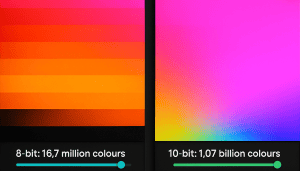In the world of digital displays, the quest for the sharpest, most vivid images is relentless. For digital display consultants, the debate rages on: are lower pixel pitch LED displays truly the best, or is this specification not as critical as some might believe? This blog post aims to demystify pixel pitch, its significance in LED display quality, and guide you on making informed decisions.
Why Pixel Pitch Matters
Pixel pitch, often overlooked, is a fundamental aspect of digital display technology. Simply put, pixel pitch is the distance between the centers of two adjacent pixels on an LED display, measured in millimeters. This seemingly minor measurement can dramatically impact the quality of the display.
Lower pixel pitch means more pixels are packed into the same space, resulting in higher resolution. This is akin to comparing a 55″ HD television to a 55″ 4K or 8K TV. Both have the same screen size, but the 4K and 8K TVs boast far superior image quality due to their significantly higher pixel counts.

High Resolution = Better Image Quality
When it comes to digital displays, clarity is king. Lower pixel pitches invariably lead to higher resolutions. This not only enhances image sharpness but also ensures that content is rendered with incredible detail and vibrancy. Whether it’s a corporate presentation or entertainment content, a high-resolution display captivates and retains audience attention.
The difference is particularly noticeable in professional settings where detail is paramount. For instance, financial analysts relying on intricate graphs and data, or medical professionals viewing high-definition imaging, will benefit immensely from a low pixel pitch LED screen.
Pixel Pitch Comparison – Finding the Sweet Spot
The optimal pixel pitch is influenced by several factors, including viewing distance and application. Outdoor video walls, where viewers are typically more than 10 metres away, can suffice with a higher pixel pitch. Here, a lower-cost, higher pixel pitch display can still deliver clear and impactful visuals without straining the budget.
Conversely, indoor settings such as conference rooms or retail environments require a lower pixel pitch. Viewers are closer to the screen, and the demand for high-definition content is greater. In these scenarios, investing in a lower pixel pitch LED display is crucial to achieving the desired visual impact.
Content Delivery Challenges of Fine Pitch LED
High-resolution displays come with their own set of challenges, particularly concerning content delivery. Media servers capable of handling millions of pixels, such as those required for 8K and higher resolutions, can be prohibitively expensive. Additionally, creating content that takes full advantage of these resolutions is both technically demanding and costly.
It’s essential to weigh these factors when recommending solutions to clients. A stunning display is only as good as the content it showcases, and ensuring seamless content delivery without breaking the bank is key to a successful deployment.
Case Study – Pixel Artworks Lighthouse
A compelling example of the impact of pixel pitch on display quality is the Pixel Artworks Lighthouse. This project adopted a 1.93mm pitch, setting a new standard for high-resolution, immersive displays. By opting for a lower pixel pitch, Pixel Artworks ensured their content was presented in unparalleled detail and clarity, significantly enhancing viewer engagement.
![]()
Benefits of Lower Pixel Pitch for Various Applications
Corporate Environments
In corporate settings, where presentations and video conferences are routine, a lower pixel pitch ensures that text and graphics are crystal clear. This enhances communication and ensures that no detail is lost, even in a large meeting room.
Retail and Advertising
For retail spaces and advertising, the visual appeal is paramount. Fine pitch LED displays create vibrant, eye-catching visuals that attract and retain customer attention. This can translate into increased foot traffic and higher sales.
Entertainment and Events
Events and entertainment venues benefit immensely from high-resolution displays. Whether it’s a concert, sporting event, or theatre production, a lower pixel pitch ensures that every seat in the house enjoys a stunning visual experience, adding to the overall impact of the event.
Balancing Cost and Quality
While lower pitch displays offer numerous benefits, they come at a higher cost. It’s crucial to balance the desire for top-tier image quality with budget constraints. In some cases, a slightly higher pixel pitch may be a more feasible option without significantly compromising on quality.
Educating clients about the cost-to-benefit ratio is essential. Highlighting scenarios where a higher investment in finer pitch displays can yield substantial returns, such as in high-traffic retail environments or high-stakes corporate settings, can help them make informed decisions.
Future-Proofing Your Investment
With technology advancing rapidly, future-proofing is a vital consideration. Investing in lower pixel pitch displays can ensure that your digital installations remain relevant and competitive for years to come. This is particularly important in industries where visual quality is a key differentiator.
Practical Tips for Pixel Pitch Implementation
Assess Viewing Distance
Determine the average viewing distance to select the appropriate pitch. Closer viewing distances necessitate lower pitches for optimal clarity.
Evaluate Content Needs
Consider the type of content that will be displayed. High-detail content, such as text-heavy presentations or intricate graphics, benefits most from lower fine pitches.
Budget Wisely
Balance the desire for denser pitches with budget limitations. In some cases, a compromise on pixel pitch may be necessary to stay within budget while still delivering high-quality visuals.
Conclusion – The Right Pixel Pitch for Your Needs
In conclusion, fine pitch LED displays offer undeniable advantages in terms of resolution and image quality. However, the decision to opt for a narrow LED pitch should be guided by a thorough assessment of viewing distances, content needs, and budget constraints.
For digital display consultants, understanding the nuances of pixel pitch is crucial to making informed recommendations that meet client expectations and deliver exceptional visual experiences. To explore more about optimising LED display quality, consider consulting with industry experts or accessing specialised resources.
Remember, the goal is not just to install a display but to create an engaging visual narrative that leaves a lasting impression. By leveraging the power of lower pixel pitches, you can elevate the visual impact of any digital display installation.
For further insights and personalised advice, connect with our team of experts and take the first step towards transforming your visual displays. Let’s make every pixel count!





